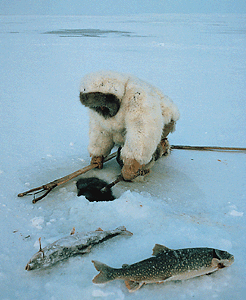Modern Inuit Not Related to Earliest Arctic Inhabitants
September 2, 2014
Present-day Inuit people have virtually no genetic relationship with the earliest populations to inhabit the region, a surprising study of genetic material from prehistoric and modern Arctic peoples have shown. The analysis was conducted by scientists at the University of Copenhagen in Denmark. Archaeologists use the term Paleo-Eskimo to describe the earliest Arctic peoples who migrated into Arctic North America about 4,000 years ago. Many scientists assumed that these Paleo-Eskimos contributed to the ancestry of modern Inuit people as they were assimilated into Inuit society through intermarriage. However, genetic and archaeological evidence now strongly indicates that although Inuit ancestors and Pale-Eskimos shared the territory for a time, intermarriage and interbreeding was rare if it occurred at all.
The earliest Paleo-Eskimo people are called the Saqqaqs by archaeologists. They lived in small bands that hunted seal and caribou in the region beginning more than 4,000 years ago. The Tuniit people followed the Saqqaqs into Arctic North America in a series of migrations from across the Bering Strait. The Inuit refer to the people who inhabited the Arctic before they arrived as the Tunitt. Archaeologists refer to the Tuniit as the Dorset culture. The Tuniit/Dorset people hunted seals, walruses, and narwhals. They spread across Canada to Greenland by about 500 B.C. But the Tuniit/Dorset people disappeared soon after another new culture called the Thule spread across the region about 1,000 years ago. The Thule people lived in villages. Whaling was the cornerstone of their culture. They also hunted on land with dog sleds and bow and arrow. By about 1700, the Thule culture had become the modern Inuit culture.

An Inuk fisher uses a pronged spear called a leister to catch his fish. Recent studies have revealed that modern Inuit are not related to the earliest inhabitants of Arctic North America. © Bryan & Cherry Alexander, Photo Researchers
In their study, the University of Copenhagen scientists collected bone, teeth, and hair samples from the preserved bodies of 169 ancient Paleo-Eskimo bodies from North America. The scientists isolated DNA from these samples and compared it to genomes sequenced from living Inuit and other Native American peoples. Native American groups are often reluctant to provide biological samples for genetic studies, but special tribal permission was given for this study.
The scientists found that the Paleo-Eskimo DNA samples were remarkably similar to each other yet genetically distinct from modern Inuit. The high degree of similarity in Paleo-Eskimo DNA suggests their populations were quite small. Over thousands of years, Paleo-Eskimo groups, each perhaps no more than 50 related individuals, spread out across the vast Arctic expanse. However, they apparently did not interact with the Thule once they migrated into the region. The Paleo-Eskimos disappear from the archaeological record within a period of perhaps decades after the first Thule arrival. The abrupt disappearance of the Tuniit/Dorset people soon after this event remains mysterious. Archaeologists have not found any evidence of violent conflicts between Tuniit and the newly-arrived Thule. Some researchers suspect that the technologically advanced Thule may simply have out-competed the Paleo-Eskimo cultures in the rugged environment and pushed them towards extinction.


